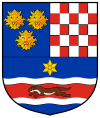Kingdom of Croatia and Slavonia
| Kingdom of Croatia and Slavonia | |||||
|
Sub-country Kingdom of Hungary (1745–1804 and 1918) Austrian Empire (1804–1867) Transleithania in Austria-Hungary (1867–1918) |
|||||
|
Horvát-Szlavón Királyság Kraljevina Hrvatska i Slavonija |
|||||
| 1745-1918 | |||||
|
|
|||||
| The Kingdom of Croatia-Slavonia in the 20th century | |||||
| Form of government | monarchy | ||||
| Capital | Zagreb | ||||
| language |
Hungarian Croatian |
||||
| Today part of |
Croatia Serbia |
||||
| history | |||||
| • Unification of the Kingdoms of Croatia and Slavonia within the Habsburg Monarchy | 1745 | ||||
| • Dissolution of Austria-Hungary | 1918 | ||||
The Kingdom of Croatia and Slavonia ( Croatian Kraljevina Hrvatska i Slavonija; Hungarian Horvát-Szlavón Királyság ) was an autonomous kingdom within the Habsburg Monarchy and the Austrian Empire (from 1804) as a neighboring country to Hungary . In the Austro-Hungarian monarchy (1867-1918) it belonged to the Hungarian part of the dual monarchy and included parts of today's Croatia and Vojvodina in today's Serbia .
It was also referred to as the Triune Kingdom of Dalmatia, Croatia and Slavonia , because the initially Venetian Dalmatia was part of the country according to government practice, but was nominally not united with the other two territories even after the Austrian occupation in 1797. The three areas were called the Kingdom of Illyria from 1767 to 1777 and were ruled by an "Illyrian" court deputation in Vienna.
history
The Kingdom of Croatia and Slavonia was created in 1745 by Maria Theresa , monarch of the Habsburg Monarchy, through the unification of the Kingdoms of Croatia and Slavonia .
After the end of the Napoleonic occupation in 1814, Illyria was restructured under Emperor Franz I of Austria, and the area now officially known as the Kingdom of Croatia and Slavonia was crownland from then until 1867 , as was the Kingdom of Dalmatia, which existed independently .
From 1849 to 1860 the crown land of Serbian Vojvodina existed , which was then divided up between Hungary and Croatia-Slavonia like the former military border that was dissolved .
After the Austro-Hungarian settlement of 1867, with which the countries of the Hungarian crown became politically independent from the Viennese government, in the same year, with the Hungarian-Croatian settlement, Croatia-Slavonia was granted greater autonomy within the Hungarian crown. Contrary to the wishes of the Croatian majority, a formal union with the Kingdom of Dalmatia , which remained part of the Austrian half of the empire ( Cisleithanien ) , continued to fail. Only a common flag and common symbols were allowed for the two crown lands.
In 1872 and 1881 the Croatian-Slavonian military border was dissolved, with large parts of the country being administered directly by the Court War Council or its successor, the War Ministry in Vienna .
The kingdom lasted until 1918 when it was incorporated into the Kingdom of Serbs, Croats and Slovenes . After the proclamation of the Kingdom of Yugoslavia in 1929, a large part of the Croatia-Slavonia area became part of the Sava Banschaft .
Regional division

The Kingdom of Croatia and Slavonia was divided into eight administrative regions ( counties ).
- Bjelovar-Križevci ( Bjelovar )
- Lika-Krbava ( Gospić )
- Modruš-Rijeka ( Ogulin )
- Požega ( Požega )
- Syrmia ( Vukovar )
- Varaždin ( Varaždin )
- Virovitica ( Osijek )
- Zagreb ( Zagreb )
Demographics
The population indicated the following languages as their mother tongue in the censuses:
| 1880 | 1890 | 1900 | 1910 | |
|---|---|---|---|---|
| Croatian | 1,712,353 (90.5%) | 1,359,588 (62.2%) | 1,490,672 (61.6%) | 1,638,354 (62.5%) |
| Serbian | 562,131 (25.7%) | 614,443 (25.4%) | 644,955 (24.6%) | |
| German | 83,139 (4.4%) | 117,493 (5.4%) | 136,121 (5.6%) | 133,418 (5.1%) |
| Hungarian | 41,417 (2.2%) | 68,794 (3.2%) | 90,781 (3.8%) | 105,047 (4.0%) |
| Slovak | 9,078 (0.5%) | 13,614 (0.6%) | 17,476 (0.7%) | 21,613 (0.8%) |
| other languages | 46,512 (2.4%) | (2.9%) | (2.9%) | 79,296 (3.0%) |
| total | 1,892,499 | 2,184,414 | 2,416,304 | 2,621,954 |
NB: In 1880 Croatian and Serbian were counted together.
The religious
relationships in 1900: Roman Catholic: 1,721,416 (71.24%)
Greek Catholic: 12,871 (0.53%)
Orthodox: 616,518 (25.51%)
Protestant AB: 30,082 (1.24%)
Protestant HB: 13,010 (0.54%)
Israelite: 20,216 (0.84%)
Historical literature
- Archduke Rudolf : The Austro-Hungarian monarchy in words and pictures. Volume 24: Croatia and Slavonia. kk Hof- und Staatsdruckerei, Vienna 1902 ( online ).
- Ignaz de Luca: Illyria: The Kingdom of Slavonia and The Kingdom of Croatia. In: Geographisches Handbuch von dem Oestreichischen Staats. 4th volume Ungern, Illyria, and Transylvania. Verlag JV Degen, Vienna 1791, pp. 427-440 ( Google eBook ) resp. 441–450 ( ibid., Both complete view ).
Individual evidence
- ^ A b Wolfgang Kessler: Politics, culture and society in Croatia and Slavonia in the first half of the 19th century: Historiography and foundations . Oldenbourg, Munich 1981, ISBN 3-486-49951-3 , p. 9 .


